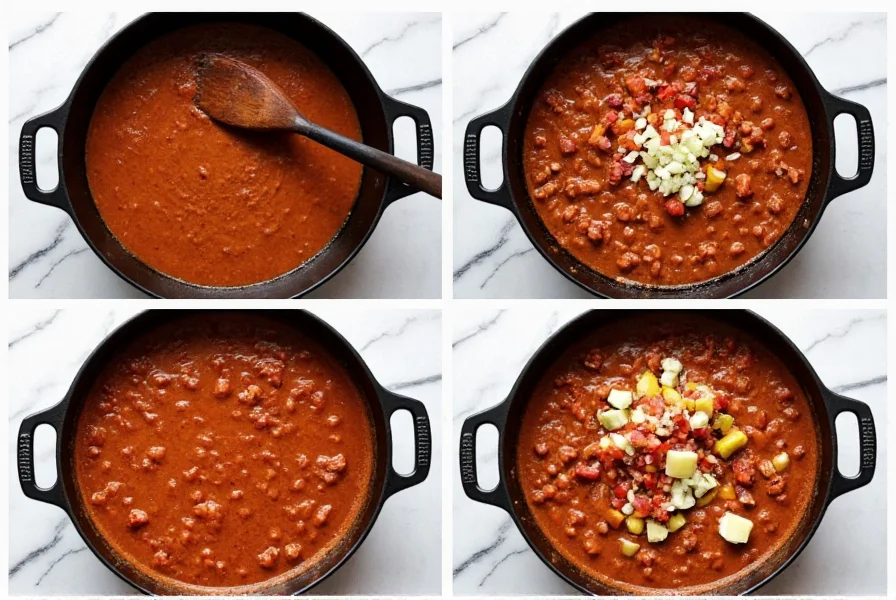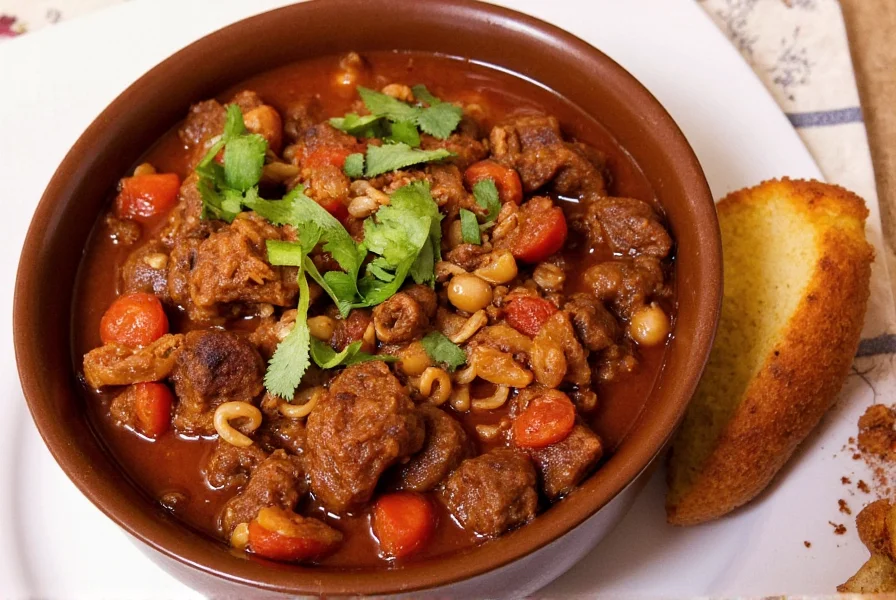Bison chili has gained popularity among health-conscious cooks and culinary enthusiasts seeking a nutritious alternative to conventional beef chili. Unlike domesticated cattle, bison are typically raised without hormones or antibiotics on open grasslands, resulting in meat that's naturally leaner yet remarkably flavorful when prepared correctly.
The Nutritional Advantage of Bison Meat
When comparing bison to beef, the nutritional differences are substantial. A 4-ounce serving of cooked bison contains approximately 140 calories and 6 grams of fat, compared to 220 calories and 14 grams of fat in the same portion of lean beef. Bison meat also provides 30% more iron and higher concentrations of conjugated linoleic acid (CLA), which research suggests may support metabolic health.
| Nutrient Comparison (per 4oz serving) | Bison | Lean Beef |
|---|---|---|
| Calories | 140 | 220 |
| Total Fat | 6g | 14g |
| Saturated Fat | 2.5g | 5.5g |
| Protein | 22g | 21g |
| Iron | 2.8mg (16% DV) | 2.1mg (12% DV) |
Essential Ingredients for Authentic Bison Chili
Selecting quality ingredients makes the difference between ordinary and exceptional bison chili. For the meat component, choose ground bison with 90-93% lean content—too lean and your chili may become dry during cooking. The ideal best cut of bison for chili combines ground chuck with some fat content to maintain moisture during the slow cooking process.
Traditional Southwestern spices form the flavor foundation. A proper bison chili spice blend should include ancho chili powder, smoked paprika, cumin, and a touch of cocoa powder for depth. Fresh ingredients like fire-roasted tomatoes, poblano peppers, and dark kidney beans contribute to the complex flavor profile that defines authentic chili.

Perfecting Your Bison Chili Technique
Mastering how to make bison chili tender requires attention to cooking technique. Unlike beef, bison's leanness means it can become tough if overcooked. Follow these professional tips:
- Sear properly: Brown the meat in batches to develop flavor without steaming
- Control temperature: Simmer gently at 180-200°F (82-93°C), never boiling
- Hydrate strategically: Use 25% more liquid than traditional chili recipes
- Timing matters: Cook for 1.5-2 hours maximum for optimal tenderness
Adding a splash of apple cider vinegar during the last 30 minutes of cooking helps tenderize the meat while brightening the overall flavor profile. For those wondering can you use bison instead of beef in chili, the answer is yes—but with these crucial adjustments to cooking time and liquid ratios.
Serving Suggestions and Variations
Traditional bison chili shines when served with complementary toppings that enhance its natural flavors. Consider these authentic pairings:
- Avocado slices for creaminess that balances the lean meat
- Sharp cheddar cheese to contrast the earthy meat flavors
- Cornbread made with blue cornmeal for authentic Southwestern pairing
- Radish slices for a refreshing crunch against the hearty stew
For those following specific dietary patterns, healthy bison chili recipe adaptations include omitting beans for paleo versions or adding extra vegetables like zucchini and bell peppers for increased nutrient density. The versatility of bison meat makes it suitable for various dietary approaches while maintaining exceptional flavor.

Storage and Reheating Best Practices
Proper storage ensures your bison chili maintains quality and flavor. Cool the chili rapidly by placing the pot in an ice bath before transferring to airtight containers. Refrigerated bison chili stays fresh for 3-4 days, while frozen portions maintain quality for up to 6 months.
When reheating, add a small amount of broth or water to compensate for moisture loss during storage. Gently warm on the stove over medium-low heat, stirring occasionally. Avoid microwaving large portions as this can create uneven heating that dries out the lean meat. The best way to reheat bison chili preserves both texture and flavor integrity.
Avoiding Common Preparation Mistakes
Even experienced cooks make errors when transitioning from beef to bison chili. The most frequent issues include:
- Overcooking the meat: Bison requires less cooking time than beef
- Insufficient liquid: Lean meat needs more moisture during cooking
- Over-spicing: Let the natural meat flavor shine through balanced seasoning
- Rushing the process: Proper chili development requires gradual flavor melding
Remember that bison's delicate flavor profile means you should adjust spice levels carefully. Start with reduced amounts of chili powder and cayenne, then adjust to taste after the meat has simmered. This approach prevents overwhelming bison's distinctive, slightly sweet flavor notes.
Frequently Asked Questions
Is bison chili healthier than beef chili?
Yes, bison chili is generally healthier than traditional beef chili. Bison meat contains approximately 25% fewer calories, 40% less total fat, and one-third less saturated fat than lean beef while providing more iron, zinc, and vitamin B12. The omega-3 fatty acid content in bison is also significantly higher, contributing to better heart health.
How do you keep bison meat from drying out in chili?
To prevent bison meat from drying out in chili, use these techniques: select 90-93% lean ground bison, increase liquid content by 25% compared to beef recipes, maintain a gentle simmer below boiling point, limit cooking time to 1.5-2 hours, and add a splash of acid like apple cider vinegar during the final 30 minutes of cooking. These adjustments compensate for bison's lower fat content while enhancing tenderness.
What's the best cut of bison for chili?
The best cut of bison for chili is ground bison chuck with 7-10% fat content. This provides enough marbling to maintain moisture during cooking while keeping the dish lean. Alternatively, you can combine ground round (leaner) with short rib meat (fattier) for optimal flavor and texture balance. Avoid using extremely lean cuts like eye of round, which will become tough during the cooking process.
Can you use bison instead of beef in traditional chili recipes?
Yes, you can substitute bison for beef in traditional chili recipes with some important modifications. Increase liquid content by 25%, reduce cooking time by 30-40%, lower the cooking temperature to maintain a gentle simmer, and consider adding a small amount of olive oil during the searing process. These adjustments account for bison's leanness and ensure optimal texture and flavor in your easy bison chili recipe.
How long does homemade bison chili last in the refrigerator?
Properly stored homemade bison chili lasts 3-4 days in the refrigerator when placed in airtight containers within two hours of cooking. For optimal freshness, cool the chili rapidly using an ice bath before refrigeration. The flavor often improves after 24 hours as the spices meld, making bison chili an excellent make-ahead dish for meal planning.











 浙公网安备
33010002000092号
浙公网安备
33010002000092号 浙B2-20120091-4
浙B2-20120091-4